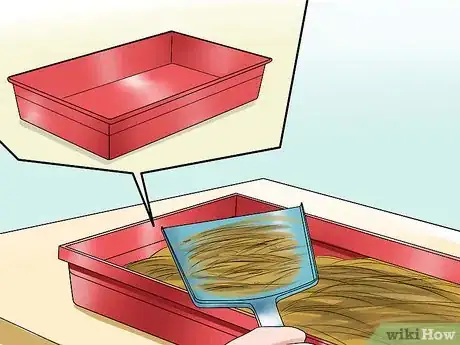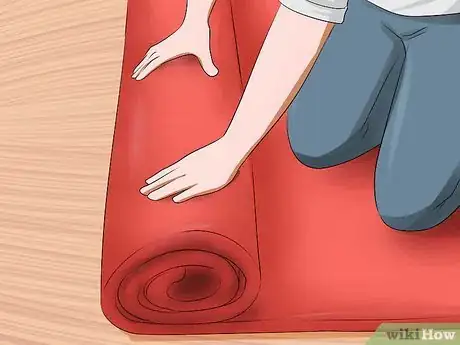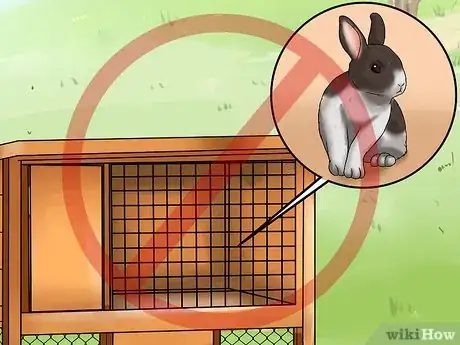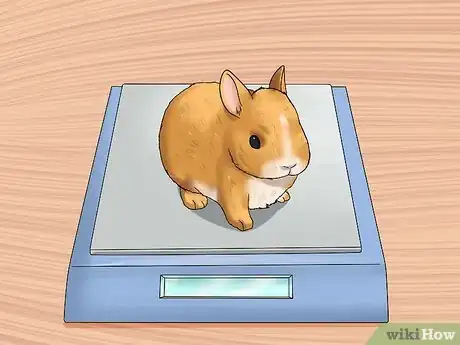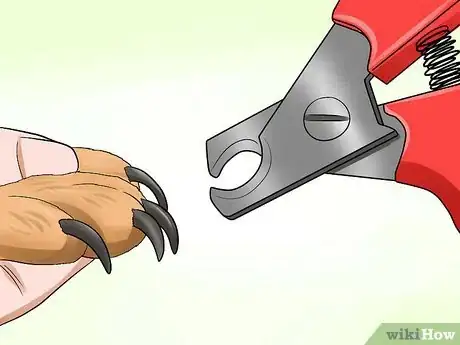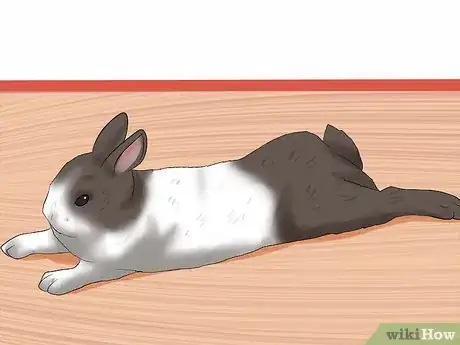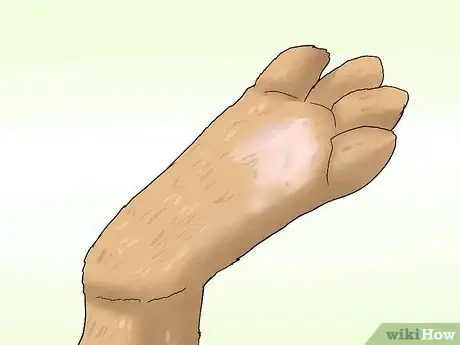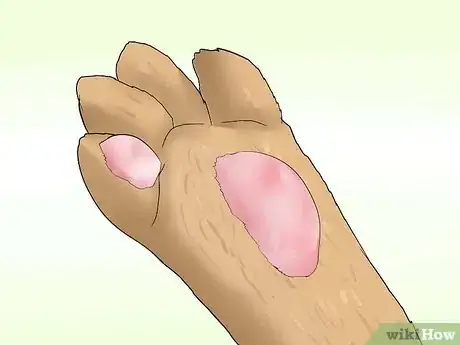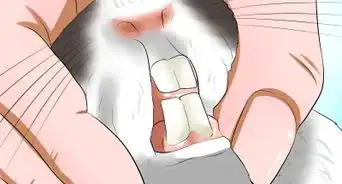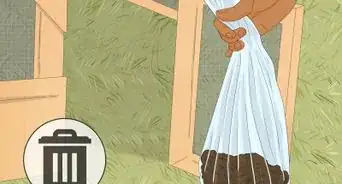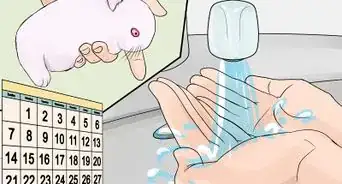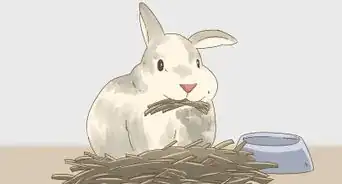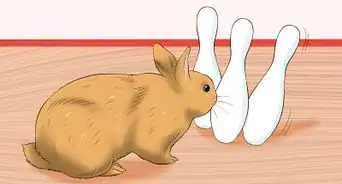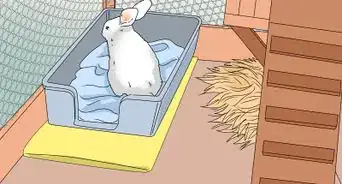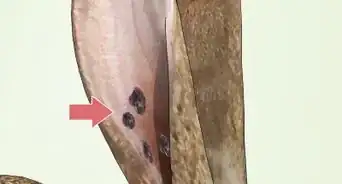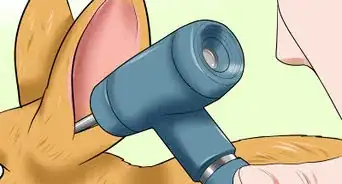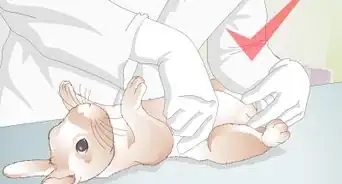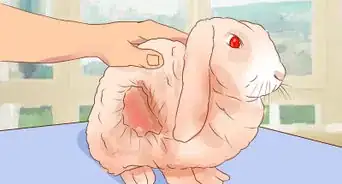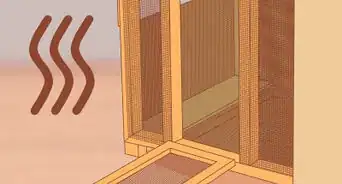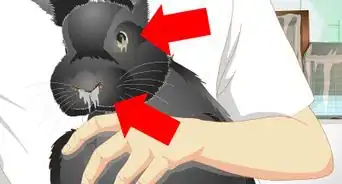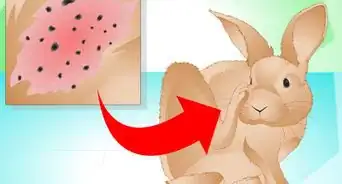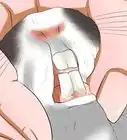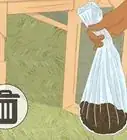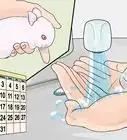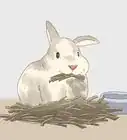This article was co-authored by Pippa Elliott, MRCVS. Dr. Elliott, BVMS, MRCVS is a veterinarian with over 30 years of experience in veterinary surgery and companion animal practice. She graduated from the University of Glasgow in 1987 with a degree in veterinary medicine and surgery. She has worked at the same animal clinic in her hometown for over 20 years.
This article has been viewed 17,364 times.
Pododermatitis, more commonly known as sore hocks, in rabbits is a common problem. This is a skin infection affecting the feet. There are several factors that make it likely a rabbit will develop pododermatitis and reducing these predisposing factors is key to preventing the condition.
Steps
Keeping the Living Quarters Safe for Rabbit Feet
-
1Change damp bedding. Damp unchanged bedding can cause sore hocks. If the bedding is not spot cleaned daily, then the rabbit risks sitting in bedding soiled with her own urine. The dampness and acidity of the urine damages the surface of the skin, weakening it and making it prone to infection.
- It is important to observe scrupulous hygiene in the rabbit's living quarters. This means scooping out soiled bedding daily and replacing it with fresh. In addition, completely clean and replace the bed on a weekly basis.
- Provide adequate deep bedding, such as three to four inches of straw, so that dampness can wick downward away from the rabbit's paws.
-
2Install appropriate flooring in your rabbit’s living quarters. Flooring is one of the main reasons rabbit’s develop sore hocks. A wild rabbit hops around on soil, which is quite a forgiving surface. You need to make sure your bunny walks around on a comfortable, forgiving surface, too. Consider putting wool rugs down to provide a padded surface that is more forgiving on the rabbit's lower limbs.[1]
- Wire-mesh flooring is inappropriate for rabbits since the mesh has a cheese-grater effect on the paws. Wire-mesh floors leads to abrasions and damage to the skin. #*Unfortunately, surfaces in the home such as laminate floor or nylon carpets can also be problematic. They are too hard, in the case of laminate, or can cause friction burns, like with nylon carpet.
Advertisement -
3Avoid placing your rabbit in cramped quarters. In the wild, rabbits forage and are constantly moving from spot to spot. If the rabbit is confined in a hutch for long periods of time, especially if those quarters are cramped, they are liable to develop pressure sores on the feet from not being able to move around. Make sure your rabbit has plenty of space to move around.
- Furnish the space your rabbit roams around in such a way as to encourage the rabbit to move around. For example, put food and water at opposite ends of the run and the shelter in another place.
- Provide toys that encourage the rabbit to move and play. Simple things like a cardboard tube stuffed with good quality hay can go a long way to encourage your rabbit to move around and keep the hocks healthy.
Keeping the Rabbit Healthy to Protect the Hocks
-
1Keep your rabbit at a healthy weight. The more weight the rabbit carries on her body, the more weight she has pressing down on her feet. Sore hocks are rare in wild rabbits, as are obese rabbits. Take care not to overfeed your rabbit and to keep her lean.
- The perfect food for rabbits is grass or a good quality green hay. Feed your rabbit hay as the majority of your rabbit's food.
- Only give a spoonful of pellets as an extra treat. Be aware that pellets are very calorie heavy, and feeding them as meals instead of treats makes it more likely your rabbit will overeat and become obese.
- If your rabbit is already too heavy, start a gradual change over from pellets to hay. Don't make any sudden changes since this could cause your rabbit to starve themself, which can cause health problems.
-
2Keep your rabbit’s claws shorter. Long claws can lead to sore hocks. If the claws of the back legs grow too long and the rabbit then walks on a hard surface, the claws have the effect of raising the toes and lowering the hocks. This then forces more pressure onto the hocks, increasing the abrasive forces and creating sore hocks.[2]
- This problem is easily sorted by regularly trimming your rabbit's nails. If you do not feel confident doing this, then a groomer or your vet can do this for a small fee. They can also show you what to do.
-
3Treat any mobility problems. Rabbits who don’t move often can get sore hocks. For example, rabbits with arthritis or with other muscular or skeletal problems may be in pain when they move, which makes them more likely to stay in one spot. This kind of behavior can predispose the bunny to sore hocks.
- If arthritis is the problem, speak to your vet about prescribing a painkilling medication that is safe for rabbits, in order to ease your pet's discomfort and encourage them to move around.
Recognizing The Symptoms of Sore Hocks
-
1Check for missing fur on the feet. To check if your rabbit has sore hocks, gently hold your bunny on her back so you can see the underside of her back legs. The condition affects the skin on the underside of the hock joint and along the foot. In the early stages all you may see is a lack of fur on the underside of the foot.
- Due to this lack of fur, the skin may start to thicken into places that look like a callus.
-
2Look for sores on the foot. Another symptom of sore hocks is sore or other irritated places on the feet. If this early stage goes unrecognized, continued pressure on the lower limb wears through the skin and pressure sores develop.
- These sores look red and angry at first with the skin surface missing.
-
3Check for signs of infection. If the missing fur or the sores on the feet go unnoticed, the sores can become infected. This means the sores will develop a sticky discharge or a scab that forms on the lower foot.[3]
- The very worst cases can have a smelly, purulent infection. When the pus is cleaned away, the skin is lost down to the bone and the subcutaneous structures are exposed.
Expert Q&A
-
QuestionCan rabbits die from sore hocks?
 Pippa Elliott, MRCVSDr. Elliott, BVMS, MRCVS is a veterinarian with over 30 years of experience in veterinary surgery and companion animal practice. She graduated from the University of Glasgow in 1987 with a degree in veterinary medicine and surgery. She has worked at the same animal clinic in her hometown for over 20 years.
Pippa Elliott, MRCVSDr. Elliott, BVMS, MRCVS is a veterinarian with over 30 years of experience in veterinary surgery and companion animal practice. She graduated from the University of Glasgow in 1987 with a degree in veterinary medicine and surgery. She has worked at the same animal clinic in her hometown for over 20 years.
Veterinarian Sore hocks are painful and debilitating. Anything that causes distress or stress in rabbits can stop them from eating. In turn, this can lead to gut stasis which is fatal unless treated.
Sore hocks are painful and debilitating. Anything that causes distress or stress in rabbits can stop them from eating. In turn, this can lead to gut stasis which is fatal unless treated. -
QuestionWhat causes sore hocks in rabbits?
 Pippa Elliott, MRCVSDr. Elliott, BVMS, MRCVS is a veterinarian with over 30 years of experience in veterinary surgery and companion animal practice. She graduated from the University of Glasgow in 1987 with a degree in veterinary medicine and surgery. She has worked at the same animal clinic in her hometown for over 20 years.
Pippa Elliott, MRCVSDr. Elliott, BVMS, MRCVS is a veterinarian with over 30 years of experience in veterinary surgery and companion animal practice. She graduated from the University of Glasgow in 1987 with a degree in veterinary medicine and surgery. She has worked at the same animal clinic in her hometown for over 20 years.
Veterinarian Wet bedding or inadequate bedding can cause sore hocks in rabbits. This condition rarely happens in wild rabbits because the mud and soil has 'give' in it, which allows their toes and claws to dig in and takes some of the pressure off their hocks.
Wet bedding or inadequate bedding can cause sore hocks in rabbits. This condition rarely happens in wild rabbits because the mud and soil has 'give' in it, which allows their toes and claws to dig in and takes some of the pressure off their hocks. -
QuestionWhat can I put on a rabbit wound?
 Pippa Elliott, MRCVSDr. Elliott, BVMS, MRCVS is a veterinarian with over 30 years of experience in veterinary surgery and companion animal practice. She graduated from the University of Glasgow in 1987 with a degree in veterinary medicine and surgery. She has worked at the same animal clinic in her hometown for over 20 years.
Pippa Elliott, MRCVSDr. Elliott, BVMS, MRCVS is a veterinarian with over 30 years of experience in veterinary surgery and companion animal practice. She graduated from the University of Glasgow in 1987 with a degree in veterinary medicine and surgery. She has worked at the same animal clinic in her hometown for over 20 years.
Veterinarian Salt water bathing is a good starting point (use 1 tsp of salt to 1 pint of cooled, previously boiled water). There are various antibacterial powders and ointments which your vet may be able to supply, but if the wound is deep or infected then getting it checked by a vet is essential.
Salt water bathing is a good starting point (use 1 tsp of salt to 1 pint of cooled, previously boiled water). There are various antibacterial powders and ointments which your vet may be able to supply, but if the wound is deep or infected then getting it checked by a vet is essential.
References
About This Article
You can prevent sore hocks in your rabbit by spot cleaning its bedding each day and replacing the entire bedding weekly, since soiled litter can irritate your rabbit’s feet. You should also make sure your rabbit has soft, padded flooring in its hutch, such as a wool rug, to protect its feet. Another way to prevent sore hocks is to keep your rabbit at a healthy weight by feeding it mostly grass or quality green hay. Additionally, make sure to keep your rabbits claws trimmed short, since long claws can cause sore hocks. To learn how to recognize the symptoms of sore hocks, read more from our Veterinarian co-author.
